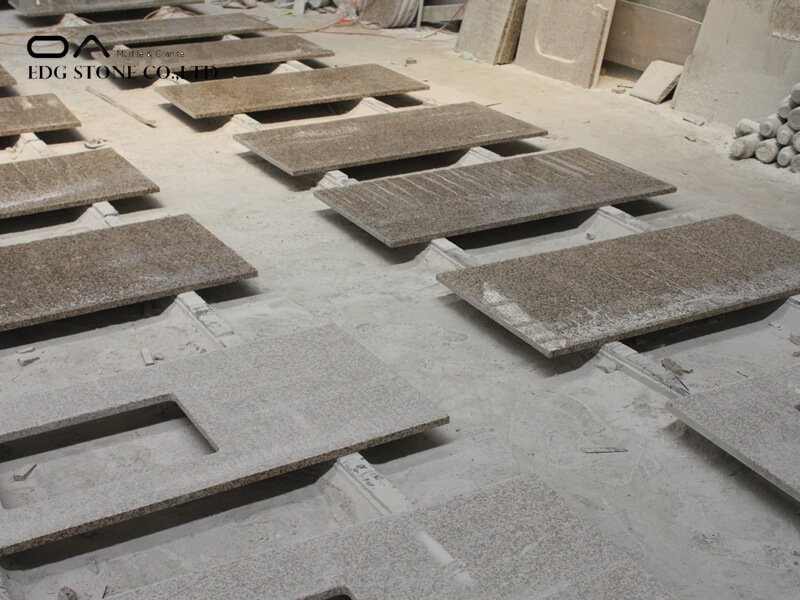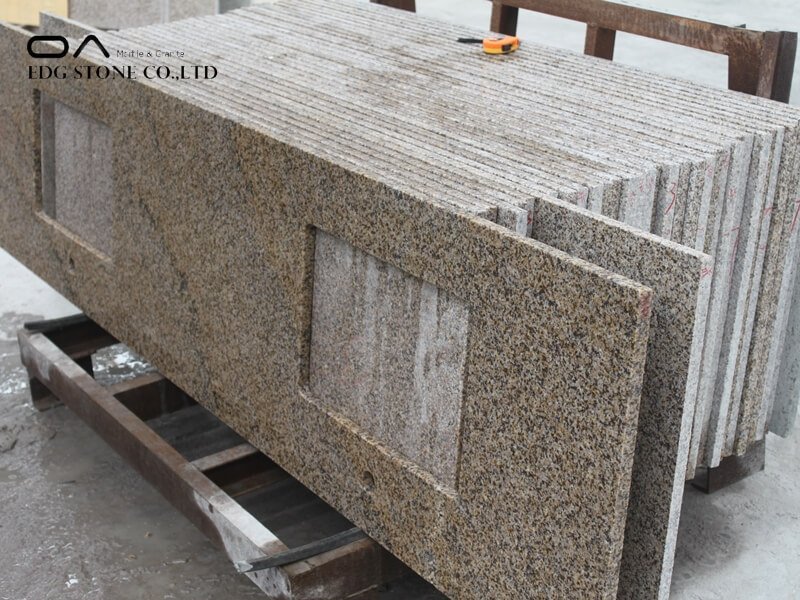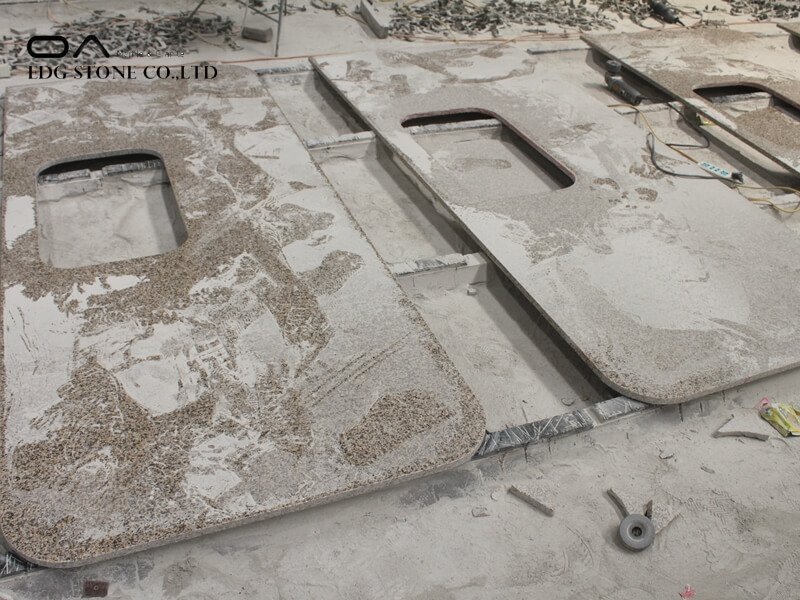1. The purchase requires that the thickness of the rough board is between 1.95-2.15cm.
2. The thickness of the purchased light board is 1.90-2.1cm, and the gloss is above 85.
3. Precautions for the big cutting process:
(1) Blocks should be placed firmly and stably on the platform.
(2) Understand and see the big cut and split schematic diagram of the stone.
(3) The correction and review of the large cutting size before cutting should be careful and accurate.
(4) After cutting the first three pieces of the block, first stop and knock off the first piece of stone skin, and check the quality of the block: whether there are quality defects such as dark cracks, color bladder, stain, color line, etc.; check the first three pieces Whether the thickness is within the allowable tolerance (20mm±5mm), and give timely correction
(5) Do a good job of machine inspection, maintenance, cleaning, and cleaning before and after the operation.
(6) Compensation: It is best to cut (height) together with the thickened board, especially for stone types with grains.
4. Matters needing attention in the thickness setting process:
(1) The actual thickness after setting the thickness is 19.5-2.0cm. Check the thickness with a vernier caliper.
(2) Be careful when operating. Pay attention to safety and avoid damaging the sheets when lifting and placing the sheets.
(3) Do a good job of machine inspection, maintenance, cleaning, and cleaning before and after the operation.
5. Matters needing attention in the large-surface polishing process:
(1) Please make up the glue before polishing, fill in the gaps of the stone slab (especially granite), and avoid waiting for the finished product to spend a lot of manpower on the cosmetic glue.
(2) The polishing process uses a full set of resin abrasives for polishing.
(3) The gloss is above 85.
(4) When lifting the board, pay attention to avoid accidentally damaging the board.
(5) The edges and corners should be polished and the gloss should be sufficient.
6. Precautions for bridge shearing process:
(1) Cut the smooth side up.
(2) The saw blade should be sharp. (Before cutting the knife, sharpen the head first)
(3) It is necessary to control the cutting speed and cutting speed.
(4) There must be a machining allowance. (The margin is 3-4mm, which is used to shape the seam to within 0.3mm when the 1/2 circle is shaped).
(5) If it is a stone with a pattern, it must be cut out with the thickened side, so that the pattern of the large surface and the pattern of the thickened side can be matched, and the finished product will be beautiful and natural. (One set has a number, and if there is a grain direction, the time direction is also marked).
(6) Avoid missing edges, missing corners, incomplete cuts, crooked cuts, and size errors.
(7) Do a good job of machine inspection, maintenance, cleaning, and cleaning before and after the operation.
7. Gluing and shaping process:
(1) The color should be carefully adjusted, try to adjust the glue to the same color as the stone.
(2) The large flat plate and the thickened plate should be as close as possible. After it is closed, fix it with an iron fixing clip and let it glue together.
(3) Before gluing, try to use contact and anastomosis sheets for gluing.
(4) The joint after gluing is not more than 0.3mm.
(5) When gluing, pay attention to scraping off the excess glue before the glue is dry, and avoid spending a lot of manpower on the glue when the finished product is beautified.
8. Notes for 1/2 round shaping process:
Because there is a machining allowance (3-4mm), the 1/2 circle should be set 3-4mm deeper than the original without machining allowance, so that the joint after gluing does not exceed 0.3mm.
9. Matters needing attention in manual processing correction process:
(1) The angle of rotation is 50 degrees.
(2) When correcting, try to make the corners excessively smooth and natural. The surface should be flat.
(3) Be careful when transporting to avoid damaging the countertop.
10. Precautions for the small surface polishing process:
(1) The sheet material should be placed on the iron frame or wooden frame to avoid damaging the edge of the countertop and keep the edges and corners intact.
(2) The gloss is above 85.
(3) Small noodle grinding should be careful and comprehensive. The straight line should be straight, the curve should be flat and smooth and natural, and the corners should be ground in place.
(4) The joints or the excessive corners should be ground until there is no hand feeling or wavy feeling, and the edges will not be scratched even when the edges are ground to a point.
11. Matters needing attention in the replenishing and beautifying process:
(1) The placement should be in strict accordance with the name and color of the stone and placed in an orderly manner. Face up, and the sides that need to be glued are in the same direction to form a straight line. This is convenient for the effective, fast, and accurate replenishing of glue and beauty.
(2) The color should be carefully adjusted, and try to adjust the glue to the same color as the stone.
(3) Master the time for the glue to dry. Avoid that the glue is too dry to be scraped off, or when the glue is not stuck, even the glue is scraped off.
(4) Be careful when refilling glue to avoid accidentally stepping on or breaking the sheet. It is strictly forbidden to sit on the sheet to make up the glue.
(5) It is strictly forbidden to place them in a disorderly manner and mix all kinds of stones together.
(6) The glue repair personnel shall be positioned according to the type or color of the stone.
(7) After repairing glue, clean up the site. Tools are neatly arranged.
12. Precautions for handling (all procedures must be paid attention to, especially forklift handling)
(1) The 102mm baffle should be placed upright, and it is strictly forbidden to lay it flat.
(2) It should be placed on a smooth surface.
(3) The glued surface should be backed with a soft material (such as foam). Avoid scratching the surface.
(4) Forklift handling should be cautious, and necessary protective measures should be taken to prevent the forklift from hitting obstacles or uneven speed and causing the sheet to fall and be damaged.
13. Matters needing attention in the packaging process:
(1) The packaging is customized according to export wooden boxes.
(2) Place and move carefully.
(3) Discharge face to face. Separate with styrofoam/foam/plastic to avoid surface damage.
(4) The wooden box must be made strong; the wooden box must be firm with needles.
14. All working procedures are processed every day, and the worksite must be kept clean, tidy, and hygienic.
15. This “Precautions for Processing Countertop Process” will be distributed by the quality control staff for each process.







